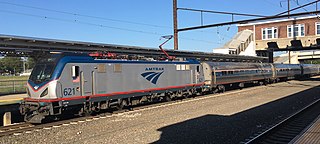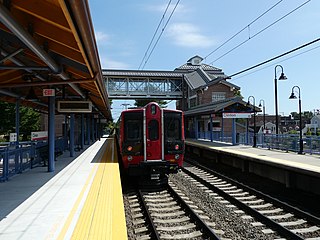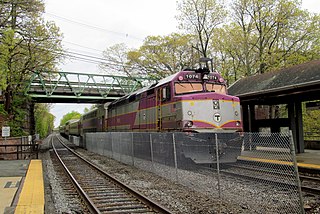
The Capitol Limited is a daily Amtrak train between Washington, D.C., and Chicago, running 764 miles (1,230 km) via Pittsburgh and Cleveland. Service began in 1981 and was named after the Baltimore and Ohio Railroad's Capitol Limited which ended in 1971 upon the formation of Amtrak. It carries the Amtrak train numbers 29 and 30, which were previously assigned to the discontinued National Limited.

The Keystone Service provides frequent regional passenger train service from Amtrak between the Harrisburg Transportation Center in Harrisburg, Pennsylvania, and 30th Street Station in Philadelphia, running along the Philadelphia to Harrisburg Main Line. Most trains continue along the Northeast Corridor (NEC) to Penn Station in New York City.

The Pennsylvanian is a 444-mile (715 km) daily daytime Amtrak train running between New York and Pittsburgh via Philadelphia. The trains travel across the Appalachian Mountains, through Pennsylvania's capital Harrisburg, the Pennsylvania Dutch Country, suburban and central Philadelphia, and New Jersey en route to New York. The entire train ride takes about 9 hours total: 1.5 hours between New York and Philadelphia, 2 hours between Philadelphia and Harrisburg, and 5.5 hours between Harrisburg and Pittsburgh.

MARC is a commuter rail system in the Baltimore–Washington metropolitan area. MARC is administered by the Maryland Transit Administration (MTA) and operated under contract by Alstom and Amtrak on track owned by CSX Transportation (CSXT) and Amtrak. In 2021, the system had a ridership of 1,291,900, or about 9,100 per weekday as of the third quarter of 2022, much less than the pre-pandemic daily ridership of 40,000 per weekday.

Pennsylvania Station, also known as Newark Penn Station, is an intermodal passenger station in Newark, New Jersey. One of the New York metropolitan area's major transportation hubs, Newark Penn Station is served by multiple rail and bus carriers, making it the seventh busiest rail station in the United States, and the fourth busiest in the New York City metropolitan area.

The Cardinal is a long distance passenger train operated by Amtrak between New York Penn Station and Chicago Union Station via Philadelphia, Washington, D.C., Charlottesville, Charleston, Huntington, Cincinnati, and Indianapolis. Along with the Capitol Limited and Lake Shore Limited, it is one of three trains linking the Northeast and Chicago. Its 1,146-mile (1,844 km) trip between New York and Chicago takes 281⁄4 hours.

Shore Line East (SLE) is a commuter rail service which operates along the Northeast Corridor through southern Connecticut, United States. The rail service is a fully owned subsidiary of the Connecticut Department of Transportation (CTDOT) and is operated under the CT Rail brand. SLE provides service seven days a week along the Northeast Corridor between New London and New Haven; limited through service west of New Haven to Bridgeport and Stamford has been suspended since 2020. Cross-platform transfers to Metro-North Railroad New Haven Line trains are available at New Haven for service to southwestern Connecticut and New York City. Pre-COVID, around 2,200 riders used the service on weekdays.

Commuter rail services in the United States, Canada, Cuba, Mexico, Panama, and Costa Rica provide common carrier passenger transportation along railway tracks, with scheduled service on fixed routes on a non-reservation basis, primarily for short-distance (local) travel between a central business district and adjacent suburbs and regional travel between cities of a conurbation. It does not include rapid transit or light rail service.

The BNSF Line is a Metra commuter rail line operated by the BNSF Railway in Chicago and its western suburbs, running from Chicago Union Station to Aurora, Illinois. In 2010, the BNSF Line continued to have the highest weekday ridership of the 11 Metra lines. While Metra does not refer to its lines by particular colors, the BNSF line's color on Metra timetables is "Cascade Green," in honor of the Burlington Northern Railroad.

The Framingham/Worcester Line of the MBTA Commuter Rail system runs west from Boston, Massachusetts to Worcester, Massachusetts through the MetroWest region, serving 17 station stops in Boston, Newton, Wellesley, Natick, Framingham, Ashland, Southborough, Westborough, Grafton, and Worcester. The third-longest and second-busiest line on the system, the Framingham/Worcester Line contends with interference from freight trains, and a number of non-handicapped-accessible stations. Service on the line is a mix of local and express trains serving Worcester plus short-turn Framingham locals.

The Keystone Corridor is a 349-mile (562 km) railroad corridor between Philadelphia and Pittsburgh, Pennsylvania, that consists of two rail lines: Amtrak and SEPTA's Philadelphia-to-Harrisburg main line, which hosts SEPTA's Paoli/Thorndale Line commuter rail service, and Amtrak's Keystone and Pennsylvanian inter-city trains; and the Norfolk Southern Pittsburgh Line. The corridor was originally the Main Line of the Pennsylvania Railroad.

The Calumet, also commonly called the Valpo Local, was a 43.6-mile (70.2 km) passenger train route operated by Amtrak between Chicago and Valparaiso, Indiana. Despite Amtrak's mandate to provide only intercity service, the Calumet was a commuter train. Transferred from Conrail in 1979, the full route was shared with Amtrak's Broadway Limited until 1990; the Calumet was discontinued the next year.

Greensburg station is an Amtrak railway station located approximately 30 miles (48 km) east of Pittsburgh at Harrison Avenue and Seton Hill Drive in Greensburg, Pennsylvania. The station is located just north of the city center. It is served only by Amtrak's Pennsylvanian, which operates once daily in each direction.

The Wolverine is a higher-speed passenger train service operated by Amtrak as part of its Michigan Services. The 304-mile (489 km) line provides three daily round-trips between Chicago and Pontiac, Michigan, via Ann Arbor and Detroit. It carries a heritage train name descended from the New York Central.

The Blue Water is a higher-speed passenger train service operated by Amtrak as part of its Michigan Services. The 319-mile (513 km) route runs from Chicago, Illinois, to Port Huron in Michigan's Blue Water Area, for which the train is named. Major stops are in Kalamazoo, Battle Creek, East Lansing, and Flint.

The Brunswick Line is a MARC commuter rail line between Washington, D.C., and Martinsburg, West Virginia, with a branch to Frederick, Maryland. It primarily serves the northern and western suburbs of Washington. The line, MARC's second longest at 74 miles, is operated under contract to MARC by Alstom and runs on CSX-owned track, including the Metropolitan, Old Main Line, and Cumberland Subdivisions. It is the successor to commuter services provided by the Baltimore & Ohio Railroad (B&O), which date to the mid-19th century.

The Penn Line is a MARC commuter rail service running from Union Station in Washington, D.C., to Perryville, Maryland, along the far southern leg of the Northeast Corridor. However, the great majority of trains terminate at Baltimore's Penn Station. It is MARC's busiest and only electric line. With trains running at speeds of up to 125 miles per hour (201 km/h), it is the fastest commuter line in the United States. The service is operated by Amtrak under contract to the Maryland Transit Administration. MARC sets the schedules, owns most of the stations, and controls fares, while Amtrak owns and maintains the right-of-way, supplies employees to operate trains, and maintains the rolling stock. It is by far the busiest of MARC's three lines, with twice as many trains and twice as many passengers as the Brunswick and Camden lines combined.

The Fort Pitt was a 117-mile (188 km) daily passenger train operated by Amtrak between Pittsburgh, Pennsylvania and Altoona, Pennsylvania. The Fort Pitt was a so-called Section 403(b) train, meaning that its operation was subsidized by the state of Pennsylvania.

The Pennsylvania Railroad Station-Wilkinsburg is located in Wilkinsburg, Pennsylvania, on Hay Street at the foot of Ross Avenue. The building was completed in 1916 when the railroad embankment through town was elevated above street level to eliminate hazardous grade crossings. The two previous stations had been located three blocks southeast along Wood Street between Franklin and Rebecca Avenues.

The PATrain, also known as Mon Valley Commuter Rail, was a commuter rail service owned by the Port Authority of Allegheny County in the Monongahela Valley in the US state of Pennsylvania. Service began in 1975 when the Port Authority assumed ownership of the Pittsburgh–McKeesport–Versailles commuter trains operated by the Baltimore and Ohio Railroad (B&O) with the support of PennDOT. The Port Authority discontinued the service in 1989.



















